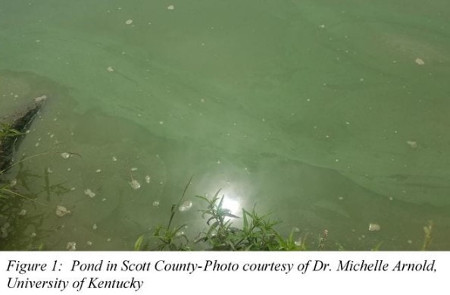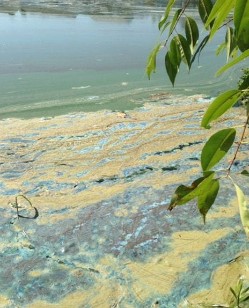By Michelle Arnold
Water is the most essential nutrient in the diet of cattle and during hot and dry weather, it is especially important to monitor water quality if using farm ponds for livestock. What is a “harmful algae bloom” or “HAB”?

During periods of hot and dry weather, rapid growth of algae to extreme numbers may result in a “bloom”, which is a build-up of algae that creates a green, blue-green, white, or brown coloring on the surface of the water, like a floating layer of paint (see Figure 1). Blooms are designated “harmful” because some algal species produce toxins (poisons) when stressed or when they die. The majority of HABs are caused by blue-green algae, a type of bacteria called “cyanobacteria” that exist naturally in water and wet environments. These microorganisms prefer warm, stagnant, nutrient-rich water and are found most often in ponds, lakes, and slow moving creeks. Farm ponds contaminated with fertilizer run-off, septic tank overflow or direct manure and urine contamination are prime places for algae to thrive. Although blooms can occur at any time of year, they happen most often in the warmer months between June and September when temperatures reach 75 degrees or higher and ponds begin to stagnate. HABs can reduce water quality and intake, but more importantly, they can be deadly when ingested by livestock. Windy conditions can push algal blooms along water edges, increasing the risk for livestock to ingest algae when they drink.
Are all algal blooms poisonous to cattle?
Of the more than 2000 species of blue-green algae identified, at least 80 are known to produce toxins (poisons) that can affect animals and humans (see Table 1 for the most common toxins). Blue-green algae toxins are released when algal cells are damaged and die in the water (for instance, after water is treated with an algaecide such as copper sulfate), or when ingested water reaches the animal’s digestive tract and algal cells are disrupted, releasing the toxins. The most common species of blue-green algae in North America associated with livestock poisoning are Anabaena (also known as Dolichospermum), Aphanizomenon, Oscillatoria, and Microcystis. Microcystis is the most common bloom-forming genus, and blooms are typically a greenish, thick, paint-like (sometimes granular) material that accumulates along shores. If an algal bloom is noticed, testing of water samples with the algae is recommended because it is impossible to tell visually if a water source contains blue-green algae or not, or to determine which specific species is present without laboratory identification. Be aware that just having a blue-green algae bloom present in a pond does not automatically mean toxins are being produced but it is best to assume the water could be dangerous if used for livestock drinking water.
What are the most common signs of poisoning in cattle from blue-green algae?

Livestock are most at risk when drinking contaminated water or licking algae from their hair coat. Most cattle exposed to blue-green algae toxins die quickly and are often found dead very near the water source. Cyanobacterial toxins (“cyanotoxins”) primarily harm the liver and/or nervous system and have been implicated in both human and animal illnesses and deaths worldwide. Some algae produce potent neurotoxins (toxins affecting the nervous system), most often the toxin Anatoxin-A, that may cause cattle to exhibit muscle tremors, difficulty breathing, wobbly gait, seizures, profuse slobbering, diarrhea, and rapid death within minutes to hours. Other algae types produce hepatotoxins (toxins affecting the liver), most commonly the microcystin toxin, that can cause sudden death or a more delayed onset of death after signs of liver failure develop, including lethargy, diarrhea, and weakness. Cattle that survive the acute stages of liver damage may develop photosensitization, a skin condition in which white (light or non-pigmented) areas of skin along the back, face, sides of udders, muzzle, underside of tongue, lips, eyelids, and ears will become red and swollen then will become crusty and peel. The only treatment for exposure to any cyanotoxin is supportive care and medications to alleviate the symptoms.
Are humans affected by these toxins, too?
Human poisoning associated with cyanotoxins most commonly occur after exposure through drinking contaminated water or after participating in water recreational activities. Exposure can result in a number of symptoms in people including skin rashes; eye, nose, mouth, or throat irritation; allergic reactions; headache and malaise; and gastrointestinal upset including abdominal pain, nausea, vomiting, and diarrhea. In humans, it is believed the toxin must be ingested for fatalities to occur. For protection of human health from exposure to the algae and any of the toxins, many states use the World Health Organization (WHO) guideline level of 100,000 algal cells/ml water or a microcystin toxin level of 6 parts per billion (ppb) for a Recreation Advisory and beaches will be closed if the microcystin toxin level reaches 20 ppb. For more information, visit the EPA website to view “A Water Utility Manager’s Guide to Cyanotoxins” at https://www.epa.gov/sites/production/files/2016-06/documents/water-utility-managers-guide-cyanotoxins.pdf
How do I test water for blue-green algae toxins?
Unfortunately, testing water for the actual toxin is problematic because toxins are not uniformly distributed in the water source, testing can be quite expensive, and there are many blue-green algae toxins for which no diagnostic tests exist. The Kansas State Veterinary Diagnostic Laboratory accepts water samples for blue-green algae identification by microscopy and will also test for the amount of microcystin, the most common toxin. When sampling water, make sure to wear gloves and collect at least 500 mls (16 ounces) of water approximately one inch below the water surface. Samples should be refrigerated before and during shipping but do not freeze. Please visit their website http://ksvdl.org and search under “algae” for further information regarding sampling, shipping and pricing. The Indiana Department of Environmental Management released a “Blue-Green Algae Sampling Resource List” in 2014 of companies that provide blue-green algae sampling and analysis services. The list can be found at
http://www.in.gov/idem/algae/files/bluegreen_sampling_services.pdf . Many algal blooms in Kentucky are composed of harmless green algae which may look like underwater moss, stringy mats or floating scum. There are a couple of simple field tests a pond owner can do to quickly assess the likelihood of blue-green algae in the water. The instructions from the Kansas Department of Health and Environment for the “Jar and Stick Tests” may be found at http://www.kdheks.gov/algae-illness/download/Jar_Test.pdf . Remember these field tests are not even close to 100% accurate so follow-up testing is recommended to definitively determine what algae species are present.

How do I prevent poisoning from Blue-Green Algae for livestock and pets:
- Always assume that a blue-green algal bloom is toxic.
- Provide constant access to clean, clear fresh water and fence off or otherwise prevent access to stagnant, scum-covered ponds. Fencing off surface water sources and providing alternative clean water sources is the best option for healthy cattle for many reasons, not just HABs.
- Do not allow animals to contaminate the water with feces and urine. Prevent fertilizer or manure runoff from entering water sources. Phosphorous is particularly important in fueling cyanobacteria growth (see Figure 2).
- If a water source is treated with an algaecide such as copper sulfate, prevent animal access to the water for at least a week or longer to allow degradation of any released toxins in the water. It is best to wait until the pond is no longer stagnant and test the water before allowing animals to drink from it.
- Creating and maintaining natural buffers such as grass strips, trees and shrubs between farmland, housing developments and waterways can help filter out excess nitrogen and phosphorus before they reach the water.

How do I prevent poisoning from Blue-Green Algae for Humans:
- Do not swim or allow children or pets to swim in water with scum layers or blooms. Avoid jet-skiing, windsurfing, tubing, or water-skiing over scum or blooms.
- Do not use untreated water for drinking, cleaning food, or washing camping gear.
- Do not boil water to remove blue-green algae; this will not remove algal toxins.
- If you come into contact with a bloom, wash your skin and hair thoroughly. If your pet comes into contact with a bloom, wash it thoroughly with clean water to prevent blue-green algae ingestion when your animal licks itself.
- Do not eat fish or shellfish caught or harvested in a bloom area.
- Respect any water body closures by public health authorities.